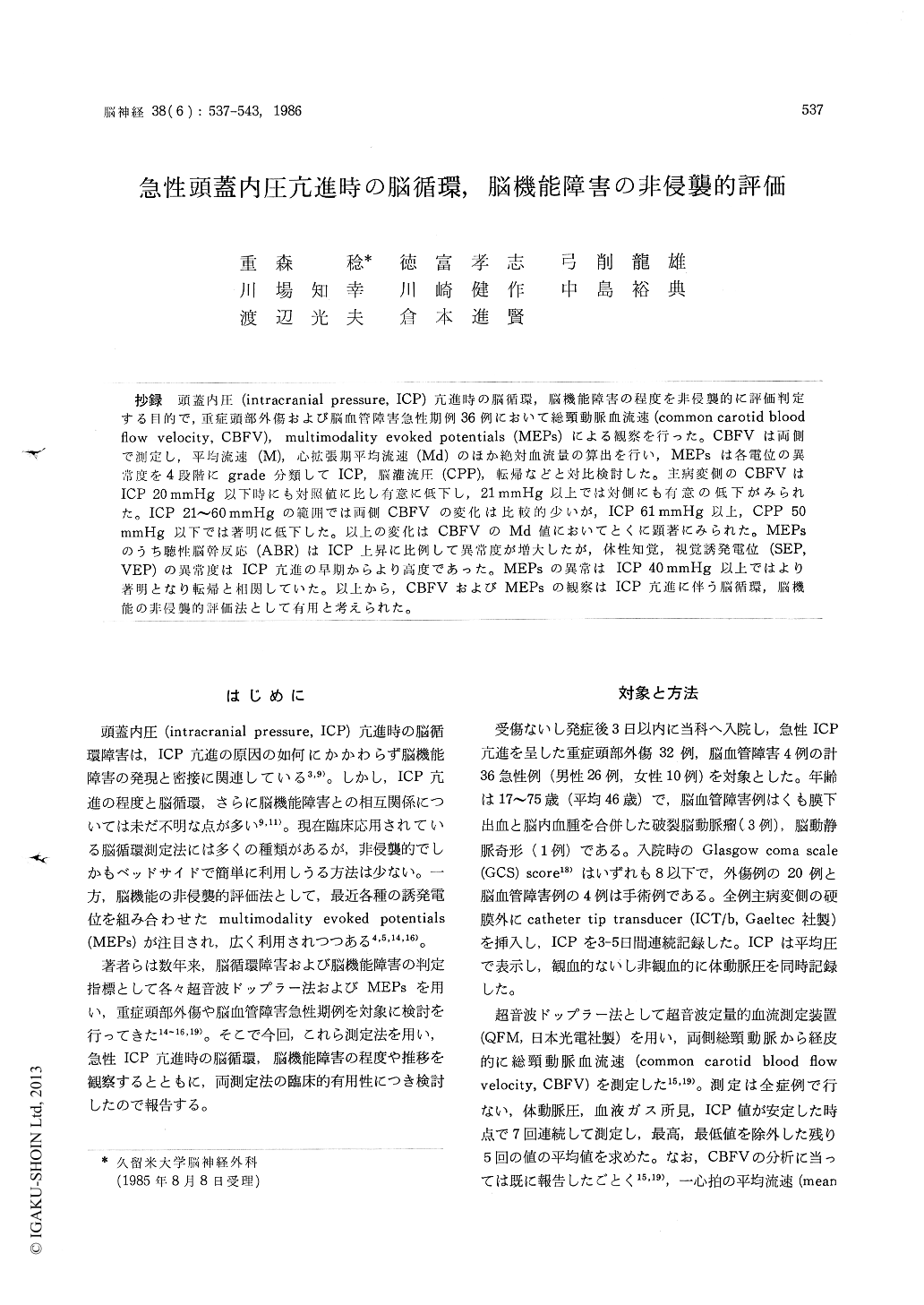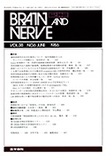Japanese
English
- 有料閲覧
- Abstract 文献概要
- 1ページ目 Look Inside
抄録 頭蓋内圧(intracranial pressure, ICP)亢進時の脳循環,脳機能障害の程度を非侵襲的に評価判定するEl的で,重症頭部外傷および脳血管障害急性期例36例において総頸動脈血流速(common carotid bloodnow velocity, CBFV), multimodality evoked potentials (MEPs)による観察を行った。CBFVは両側で測定し,平均流速(M),心拡張期平均流速(Md)のほか絶対血流量の算出を行い,MEPsは各電位の異常度を4段階にgrade分類してICP,脳灌流圧(CPP),転帰などと対比検討した。主病変側のCBFVはICP 20mmHg以下時にも対照値に比し有意に低下し,21mmHg以上では対側にも有意の低下がみられた。ICP 21〜60mmHgの範囲では両側CBFVの変化は比較的少いが,ICP 61mmHg以上,CPP 50mmHg以下では著明に低下した。以上の変化はCBFVのMd値においてとくに顕著にみられた。MEPsのうち聴性脳幹反応(ABR)はICP上昇に比例して異常度が増大したが,体性知覚,視覚誘発電位(SEP,VEP)の異常度はICP亢進の早期からより高度であった。MEPsの異常はICP 40mmHg以上ではより著明となり転帰と相関していた。以上から,CBFVおよびMEPsの観察はICP亢進に伴う脳循環,脳機能の非侵襲的評価法として有用と考えられた。
Disturbance of the hemispheric cerebral circula-tion and brain dysfunction in acute intracranial hypertension were evaluated noninvasively by ultasonic Doppler technique and multimodality evo-ked potentials consisting of auditory evoked brain-stem response (ABR), cortical somatosensory evoked potential (SEP) and visual evoked poten-tial (VEP) in 36 patients with severe head injury and cerebrovascular disease. Glasgow coma scale score was less than 8 in all cases and the age ranged from 17 to 75 years (mean of 46 years). Intracranial pressure (ICP) was measured from the extradural space using Gaeltec transducer and systemic blood pressure was simultaneously record-ed. Common carotid blood flow velocity (CBFV) was recorded on both sides and mean velocity (M), diastolic mean velocity (Md) and mean blood flow were calculated. The abnormalities on MEPs were graded into 4 categories.
M and Md values on CBFV were significantly (p<0.05 and p<0.01) lowered on affected side (main lesion side) even when ICP was staying less than 20mmHg comparing with control value obtained from the normal subjects (M: 19.48±3.52, Md: 15.98±2.01cm/sec). With the increase of ICP more than 21mmHg, CBFV on the contralateral side was also decreased and M as well as Md values were maintained at the lowered level during 21 to 60mmHg of ICP. A significant rapid decrease of CBFV was observed at extreme intracranial hypertension more than 61mmHg. Lowered CBFV was also noted when cerebral perfusion pressure was reduced less than 50mmHg. Intracranial hypertension induced a proportionate decrease in mean blood flow calulated too, but the changes were definite in those of Md values. MEPs show-ed nearly normal or slightly abnormal in 51.7-77.4% of each modality when ICP remained less than 20mmHg. But the abnormality on MEPs increased proportionately with the rise of ICP more than 21mmHg. MEPs abnormality was more frequently seen on SEP and VEP than ABR and 87.5-100% of MEPs showed a moderate to severe abnormality in all modalities when ICP rose more than 40mmHg. Intracranial hypertension more than 40mmHg and MEPs abnormality were well correlated with poor outcome.
These results indicate that the measurements of CBFV, especially of Md value and MEPs could be used as indices of hemispheric circulatory dis-turbance and brain dysfunction in acute intra-cranial hypertension.

Copyright © 1986, Igaku-Shoin Ltd. All rights reserved.


